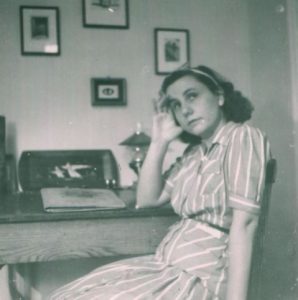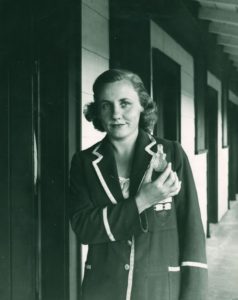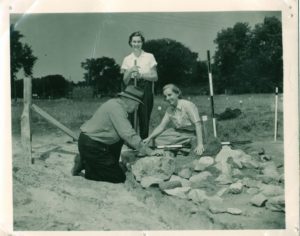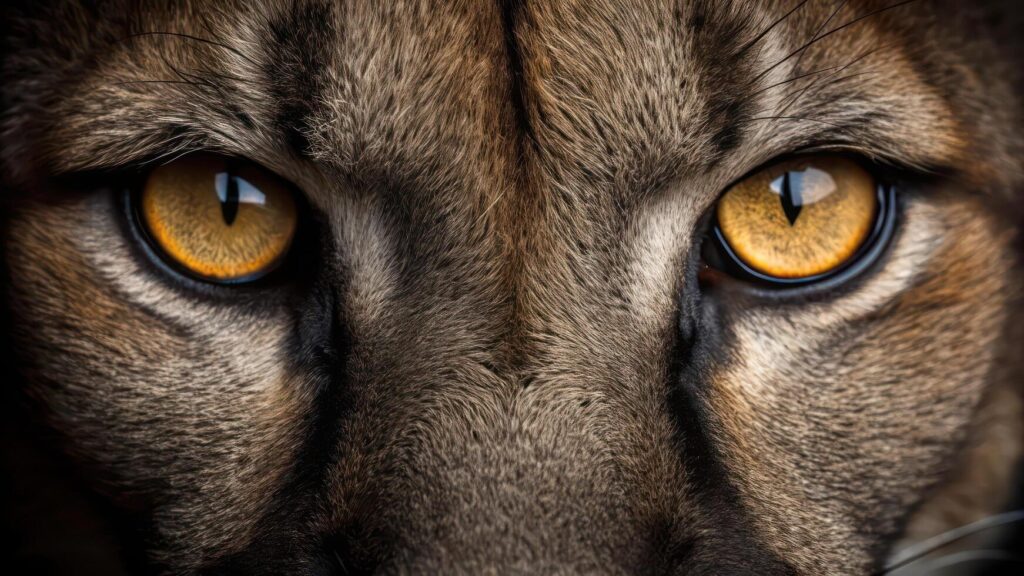Post Category : Field Life Local Archaeology Women in Archaeology
Elsie Jury
International Women’s Day
In celebration of another International Women’s Day, Ember Archaeology would like to share the life and accomplishments of another impressive archaeologist, Elsie McLeod Murray Jury. Known for being a trowel blazer in the understanding of historical archaeology in Ontario, Elsie Jury worked at many archaeological sites across the province and helped to establish the Museum of Ontario Archaeology.

Early life
Born in 1910 near Perth, Ontario, Mary Alice McLeod Murray (known to friends and family as “Elsie”) was the daughter of Irish and Scottish immigrants who had settled in Perth County in the early 20th century. Elsie attended the University of Toronto, graduating with a Bachelor of Arts degree in History and English in 1933. In 1935, she graduated from Columbia University with a Masters of Arts degree in History. Her thesis focused on the history of Scottish settlers in Perth County. After her Masters work, Elsie moved to Toronto to take a position with the Toronto Public Library, which she held until 1942. During her time in Toronto, Elsie completed a degree in library sciences from the University of Toronto (1938). During this time, she published several articles for the Ontario Library Review and the Dictionary of Canadian Biography.
Stepping into archaeology
In 1942, Elsie Murray moved to London, Ontario. She was advised by Fred Landon, a journalist and historian, to take a research position with the University of Western Ontario Library. In this role, Elsie conducted several research projects for Western University, publishing articles in several academic journals. Throughout this time, Elsie was very active in the Ontario Historical Society, frequently meeting with her peers to discuss areas of interest and delivering talks on Ontario’s history. It was also during this time that Elsie met archaeologist Wilfrid Jury, who had hired Elsie to conduct historical research on the old mission/township of Fairfield. Fairfield is a settlement on the north bank of the Thames River, founded by Indigenous and Moravian missionaries from Ohio. After working together on several projects, Elsie and Wilfrid married in 1948. This was the start of a long and fruitful partnership!

The Archaeology of Huriona
Elsie and Wilfrid worked on many archaeological projects together during the course of their 33 year partnership. The primary focus of their archaeological work was in Huronia, a region of Ontario between Lake Erie and Lake Huron. This region is home to the Wendat, or Huron people, an Iroquoian-speaking group. Elsie and her husband focused much of their archaeological efforts in this area of Ontario, excavating several important pre-hisory and historical sites.
Their first excavations were the Crawford village and Burley sites in Lambton County. Both sites yielded surprising information! Crawford Village is defined as the most western location of Iroquoian sites in Ontario. Additionally, the Burley site yielded one of the first radiocarbon dates for any archaeological site in Canada, dating to the Initial Woodland period (900 B.C. – 500 A.D.) through to the Late Ontario Iroquoian period (1400 – 1500 A.D.).

Professional contributions
Perhaps one of the most well known sites of Elsie’s career is Sainte-Marie (I-II), a French Jesuit settlement near modern day Midland, Ontario. Sainte-Marie is recognized as a National Historic Site of Canada, and excavations began in 1844. Progress continued sporadically until 1941, when Kenneth Kidd of the Royal Ontario Museum overtook the management of the site. In 1948, Elsie and her husband recognized that Sainte-Marie expanded far beyond what Kidd had initially uncovered. As such, Elsie and Wilifrid continued the excavations and archival investigations of the former mission.
Over the next four years (1948 – 1951), Elsie and Wilifrid uncovered the enormity and significance of the site. Their excavations were visited by thousands of people, including students, tourists, and dignitaries. Elsie convinced the University of Western Ontario and the provincial government to establish a field school at the site, which she and Wilifrid ran from 1950 to 1963. Additionally, Elsie delivered countless lectures to students and visitors about the history of Sainte-Marie and the Huron people.
Elsie and Wilfrid worked at several other archaeological sites in Huronia. The Penetanguishene Naval and Military Establishments, started during their work at Sainte-Marie I, kept both Elsie and Wilfrid busy for over twenty years. In 1952, they were hired by the Huronia Historic Sites and Tourist Association to further uncover and restore the cultural heritage of Ontario.
Over the course of the next 30 years, Elsie and Wilifrid worked tirelessly to further our knowledge of Huronia. They operated field schools, gave lectures, established visitor centers and educational facilities, and published literature about the archaeology and history of Ontario. After Wilfrid’s passing in 1981, Elsie continued to make valuable contributions to the Museum of Ontario Archaeology and to Ontario’s cultural heritage.




